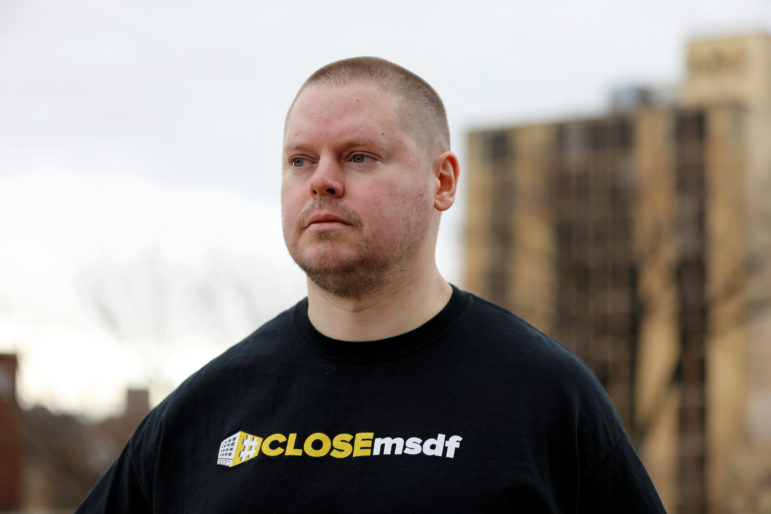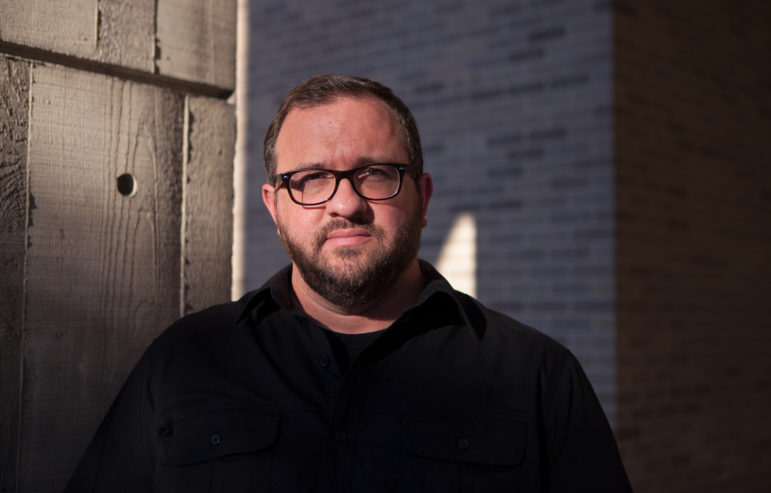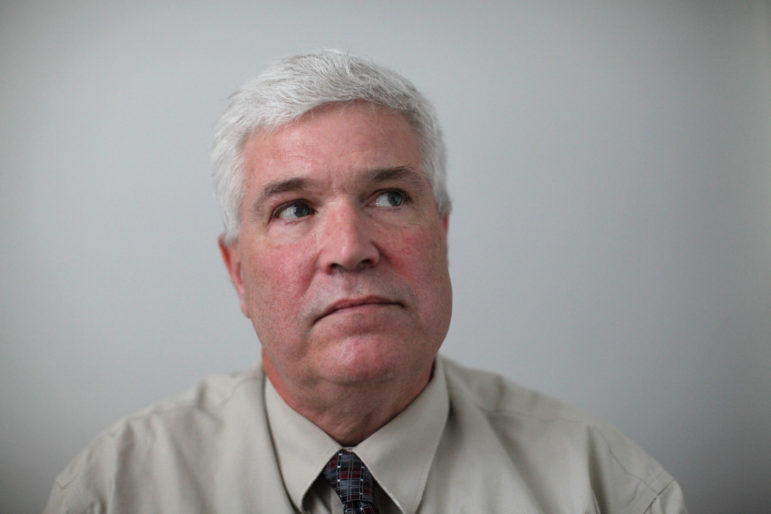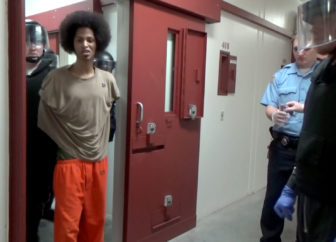Evers Faces Hurdles to Cutting Prisons
Governor promised to cut prison population by 50%, but has so far made no progress.
Gov. Tony Evers is considering enacting an obscure 30-year-old early release program and halting reincarceration of offenders for rule violations to reduce Wisconsin’s growing prison population.
In an interview with Wisconsin Watch, Evers expressed optimism about his ability to accomplish a major campaign promise: to reduce by 50 percent the state’s prison population, which is on course to hit an all-time high of 25,000 inmates by 2021.
While 31 states saw decreases in their prison populations from 2017 to 2018, Wisconsin is not one of them. Currently, Wisconsin’s prison system is 33 percent above capacity, with 18 of the state’s 20 adult prisons listed as overcrowded. The prisons are also understaffed, with 7,650 full-time equivalent employees working the equivalent of nearly 900 additional FTEs.
In a July 2018 Democratic gubernatorial candidate debate, Evers was asked whether he supported a proposal by activists to cut the state’s prison population in half: “Absolutely — and that’s a goal worth accomplishing,” he said. Unlike his predecessor, Republican Gov. Scott Walker, who drew sustained criticism for failing to fulfill a campaign pledge to create 250,000 jobs in his first term, Evers has avoided setting a deadline for halving the inmate numbers.
Evers signaled in the interview that he would favor increasing paroles, saying he believes in “second chances” and “redemption” for offenders. In addition, Evers said he wants to take a “holistic” approach to releasing inmates by helping them line up family-supporting jobs, housing and transportation for a smoother reintegration into society. And he vowed to keep pushing for more money for alternative and treatment programs to divert offenders from prison.
The Democratic governor also defended his first budget, which calls for more prison beds, not fewer. He said he is focused on longer-term solutions.
“It’s really a multifaceted project, and we’re working very hard to make sure issues around housing, substance abuse, education and so on are part of that answer,” Evers said. “If we just look at what happens just before someone’s incarcerated or potentially incarcerated or just entering or re-entering the workforce and regular life, that’s just not enough. We have to take this on in a more holistic way.”
He said he remains concerned about the racial disparities in the state’s criminal justice system — black people in Wisconsin were incarcerated at almost 12 times the rate of whites in 2017. This disparity was the second-highest in the country as of 2016.
There are some things the Democratic governor’s administration can do on its own: increase paroles, reduce or eliminate so-called crimeless revocations that send offenders in the community back to prison for rule violations and invoke a little-used state law that allows early releases in periods of overcrowding.
But other measures, such as cutting maximum sentences, reducing already-imposed sentences and diverting more offenders to treatment, would require cooperation of judges and the Republican-run Legislature, which has taken few steps in the past eight years to curb incarceration.
In a separate interview, Kevin Carr, Evers’ pick for Department of Corrections secretary, avoided endorsing a specific number. Carr said his goal is to “lower the population as low as reasonably possible and still keep the public safe.” That number could be 50 percent, he said, or it could be more or less than that.
“The governor didn’t appoint me to this position and say, ‘Here’s the keys to all the jails. Let 50 percent of the people out tomorrow,’ ” Carr said. “It has to be done in a very thoughtful, deliberate way, and we hope to achieve reductions of our current populations in our facilities by having bipartisan support.”
Mixed messages in budget
Wisconsin spends around $6 million for treatment and diversion programs each year. In his budget, Evers proposed an additional $2 million for these programs over the next two years. In May, he requested the Joint Finance Committee amend his budget to redirect $6 million for treatment and diversion, for an increase of $4 million per year. But Republicans who run the Joint Finance Committee kept it at $2 million.
Under his capital budget, Evers is proposing adding a 144-bed barracks at Taycheedah Correctional Institution, the women’s prison in Fond du Lac. He is also recommending Jackson Correctional Institution in Black River Falls add two, 144-bed barracks.
Wisdom, a statewide faith-based organization, released a statement saying Evers’ budget “is extremely disappointing in its treatment of criminal justice issues,” and “funds a growth in the prison system” rather than a reduction.
Evers defended that move.
“Doing some temporary expansion is doing nothing more than making it safe for the people that are incarcerated,” Evers said. “But I will say, just kind of pushing back a little bit, we did put a fair amount of money in the budget, and we continue to fight for that, making sure that we have mental health treatment and other alternatives and diversion programs across the state of Wisconsin.”
He added that people are being incarcerated for too long, and in certain situations, offenders could be treated in a “better, more humane way.”
Problems of overcrowded prisons
As of June 21, Wisconsin had 23,755 men and women in state prisons, one-third over the design capacity of 17,830. The population is expected to increase by about 6 percent in the next two years, according to the Wisconsin Policy Forum, which researches and advocates for efficiencies in state and local government.
Carr said in his visits to the prisons, the impact of overcrowding is “obvious,” including double-celled inmates and facilities that do not have enough resources to provide activities and programming.

Former Wisconsin inmate Mark Rice is a founder of a campaign seeking to close the Milwaukee Secure Detention Facility, which primarily houses offenders accused of violating rules while on community supervision. Rice spent six months at the prison in 2007, where he says he shared a cell made for one person with two other men. He is seen outside the Wisconsin State Capitol in Madison, Wis., on March, 14. Photo by Coburn Dukehart / Wisconsin Watch.
In some cases, inmates have been triple-celled, which is what Mark Rice experienced at Milwaukee Secure Detention Facility after being incarcerated for six months in 2007 for violating a rule of his supervision. With three people in a cell, there was little room to move. He said he was forced to sleep on the floor next to the toilet. The crowded conditions exacerbated his mental health problems, including paranoid schizophrenia, Rice said.
Former Waupun Correctional Institution psychologist Bradley Boivin, when asked about his experience working in overcrowded conditions, said around two-thirds of the inmates were double-celled during the two years he worked at Waupun before leaving in 2016.
As of June 21, the Waupun prison had a population of 1,254 — about 370 more than its design capacity. Boivin described the cells as “closet sized.” Cells are so narrow, he said, inmates can touch both walls, and the depth is barely longer than a bunk bed.
State officials declined requests from Wisconsin Watch to view and photograph prison conditions.

Former Waupun Correctional Institution psychologist Bradley Boivin says double-celling inmates can create or exacerbate mental health problems. “If these individuals were in single cells, I would say half the psych service requests wouldn’t have even existed,” Boivin says. Photo by Coburn Dukehart / Wisconsin Watch.
Putting individuals with trauma in a small space with people they might see as a threat can trigger emotions and symptoms associated with the trauma, Boivin said.
“One of the things psych services had the authority to do at Waupun, and in the DOC in general, was to put in a single-cell request for mental health reasons,” Boivin said. “Typically, security staff is required to accommodate that … but the reality is it wasn’t always honored. I had a captain tell me he wasn’t going to give an inmate the single cell, and the inmate was just trying to take advantage of me.
“If these individuals were in single cells, I would say half the psych service requests wouldn’t have even existed.”
Invoking a little-used law
One option the DOC and Evers are considering is the Special Action Release Program, a 1989 law which would authorize Carr to release parole-eligible inmates, which would primarily be those convicted before truth-in-sentencing. Evers said any releases would not happen immediately. Carr added that public safety would be the top priority.
Among the dozen requirements for special action release are that individuals are not serving a life sentence, are within 18 months of mandatory release and do not have a conviction for an assaultive crime or have a known history of assaultive behavior in or outside of prison.
While it is unclear exactly how many parole-eligible inmates would meet the criteria for the program, as of Dec. 31, there were 1,900 inmates serving time only on parole-eligible offenses, DOC spokeswoman Clare Hendricks said. Another 1,000 or so inmates could be paroled only after completing sentences for non-parole eligible offenses, she said.
Paroles set to increase?
Only about 5 percent of so-called old-law inmates have been granted parole in recent years, said David Liners, executive director of Wisdom. He said releasing half to two-thirds of the people who are parole-eligible could potentially reduce the prison population by 1,500 to 2,000 inmates.

David Liners, executive director for the faith-based group Wisdom, says boosting the number of paroles, eliminating reincarceration of offenders on community supervision for rule violations and increasing investment in alternatives to prisons will be cheaper and safer for the public. Photo taken July 14, 2016, in Dodge County Circuit Court in Juneau, Wis. Photo by Coburn Dukehart / Wisconsin Watch.
Prior to Wisconsin’s truth-in-sentencing law in 1999, offenders were eligible for release after serving 25 percent of their time and received a mandatory release after serving two-thirds of their time, after which they were paroled.
“That whole (parole) system is just broken down, and it’s a nightmare,” Liners said. “Common reasons people are given for having their parole denied, are ‘insufficient time served’ or somehow releasing them would be an ‘unacceptable risk to society’ — there’s no definition for either of those things.”
Paroles are handled by the Wisconsin Parole Commission, which is separate from the DOC. The governor appoints the commission’s chairperson for a two-year term with the consent of the state Senate.
Under Walker, paroles decreased significantly. In 2017, Walker proposedeliminating the Parole Commission and turning the responsibilities over to a gubernatorial appointee.
In May, Evers appointed Racine alderman John Tate II to serve as chairman of the commission. When asked if he would favor Tate granting more paroles, Evers said he does not want to direct Tate one way or the other and trusts his judgment. Tate has told Wisconsin Public Radio that he would like to increase the number of paroles.
Said Evers: “I’m sure he (Tate) will be not only fair, but he’ll also believe, as I do, that we have to believe in redemption, and we have to believe in making sure people get a second chance.”
Can sentences be cut?
University of Wisconsin-Madison professor emeritus of law Walter Dickey believes truth-in-sentencing legislation has been a major driver of the rising prison population. Dickey was the DOC secretary from 1983 to 1987.

With Wisconsin’s current truth-in-sentencing system, cutting the prison population in half would be extraordinarily difficult, if not impossible, says Walter Dickey, professor emeritus of law at the University of Wisconsin and former secretary of the Wisconsin Department of Corrections. Photo from the University of Wisconsin Law School.
Under the law — implemented Dec. 31, 1999 and considered one of the most punitive in the country — traditional parole was virtually eliminated for newly convicted offenders. They now receive a bifurcated sentence, which includes the time they will spend in prison and time on extended supervision following their release.
Without changes to Wisconsin’s current sentencing system, Dickey believes cutting the prison population in half would be extraordinarily difficult, if not impossible. Sentences, for the most part, cannot be shortened.
Judges can adjust sentences, but this is not a realistic method for reducing the prison population because it would take willing judges and a return to court for each case, Dickey said. In a May 2017 report, the Badger Institute found that sentence adjustment petitions are rarely approved. Out of the 2,288 petitions filed in 2016, 295 were granted, according to the institute, which advocates for free markets and limited government.
Assembly Corrections Committee chairman Rep. Michael Schraa, R-Oshkosh, does not see truth-in-sentencing going away any time soon, but he does believe changes can be made when dealing with certain offenses, such as first-time drug offenses or nonviolent crimes.
“We are not going to revamp and get rid of truth-in-sentencing in a matter of a session or two,” Schraa said. “The appetite just isn’t there, especially in the Senate. … That’s the tough thing we’re up against, but I think we can take a scalpel and come up with very effective, proven areas that we could work on.”
An April Marquette Law School poll found 55 percent of voters support early release if offenders have served two-thirds of their sentence and demonstrate they are not a threat to society. The poll also found that 71 percent favor getting rid of mandatory minimums and instead letting the judge decide sentences on a case-by-case basis.
Rep. Evan Goyke, D-Milwaukee, a member of the Assembly Corrections Committee, sees truth-in-sentencing potentially being addressed in the long term. But his focus is on more immediate fixes — revocation, release and supervision — to ease overcrowding.
“We have over 500 people sleeping in county jails because our prisons are so overcrowded that the DOC has to rent rooms in county jails,” Goyke said. “If we take a long-term view of where the system needs to go, we do need to address how we sentence the penalties associated with certain crimes and the policy of truth-in-sentencing, but where I’m really focused on the short term is handling that immediate crisis of overcrowding.”
Increasing alternatives to incarceration
An area that is more likely to receive bipartisan support from the state Legislature is expanding treatment alternatives and diversion programs, such as drug courts. The April Marquette Law School poll found 78 percent of respondents favor such programs.
Instead of “warehousing someone away,” treatment and diversion programs treat the problem and reduce recidivism, Schraa said.

Inmate Robert Tatum is seen in this video screengrab being extracted from his solitary confinement cell at the Wisconsin Secure Program Facility in Boscobel, Wis., on April 28, 2015. The Boscobel prison is among the two of Wisconsin’s 20 adult prisons that are not currently over capacity. Overall, the system has 33 percent more prisoners than it is designed to hold. Photo from the Wisconsin Department of Corrections.
Said Dickey: “Prison is for the people we’re afraid of — not the people we’re mad at. We ought to be using prison as a means to achieve public safety, and if we have people who don’t ‘need’ prison because they’re not a public safety threat, then we shouldn’t be using prison for them. We should be using some other kind of correctional resource.”
Liners said such programs are “fiscally really responsible, and the recidivism rate is much lower for people who get into TAD programs than it is for the equivalent people who go to jail. Whichever thing we’re trying to do — save money or reduce crime — they both have the same answer.”
On the national level, there are conversations about how states can reduce their prison populations. Sens. Cory Booker, D-New Jersey, and Richard Blumenthal, D-Connecticut, introduced the Reverse Mass Incarceration Act in May, which would provide a financial incentive to states that reduce their prison population by 7 percent over three years without seeing an increase in crime rate of more than 3 percent.
Both Schraa and Goyke believe Wisconsin could cut the state prison population by thousands of inmates. Liners believes the prison population could be reduced by at least 8,000 in two years by ending crimeless revocations, boosting paroles and expanding diversion programs. That would bring the prison population to around 15,700 — the same level it was in 1997.
ACLU’s Campaign for Smart Justice said Evers could reach his goal in six years by ending crimeless revocations, expanding mental health and substance abuse treatment and broadening a judge’s discretion to impose community supervision instead of prison. Its blueprint would lead to 12,170 fewer people in prison by 2025 — saving the state $886 million.
The report also recommended reducing incarceration time by speeding up parole decisions, expanding earned release and reducing sentencing ranges by 40 to 60 percent.
The report noted, however, that racial disparities likely will persist unless explicit racial justice strategies are implemented.
Evers said bipartisan efforts to cut prison populations are underway across the country, and Wisconsin should follow their lead.
“When we have people whose lives are being turned around in a negative way because they’re incarcerated for either too long or for crimes that don’t need incarceration, that’s a moral issue for me,” Evers said. “That’s why I think it’s important, and that’s why I think we’re going to be successful in the end.”
Wisconsin Watch’s collaborations with journalism students are funded in part by the Ira and Ineva Reilly Baldwin Wisconsin Idea Endowment at UW-Madison. The nonprofit Wisconsin Center for Investigative Journalism (www.WisconsinWatch.org) collaborates with Wisconsin Public Radio, Wisconsin Public Television, other news media and the UW-Madison School of Journalism and Mass Communication. All works created, published, posted or disseminated by Wisconsin Watch do not necessarily reflect the views or opinions of UW-Madison or any of its affiliates.
Cruel and Unusual
-
Jail Fees Can Leave Inmates in Debt
 Oct 4th, 2019 by Izabela Zaluska
Oct 4th, 2019 by Izabela Zaluska
-
Rules Violations Cause 40% of Prison Admissions
 Jul 3rd, 2019 by Izabela Zaluska
Jul 3rd, 2019 by Izabela Zaluska
-
Interrogation Technique Causes False Confessions?
 Jul 24th, 2017 by Krista Johnson
Jul 24th, 2017 by Krista Johnson






















